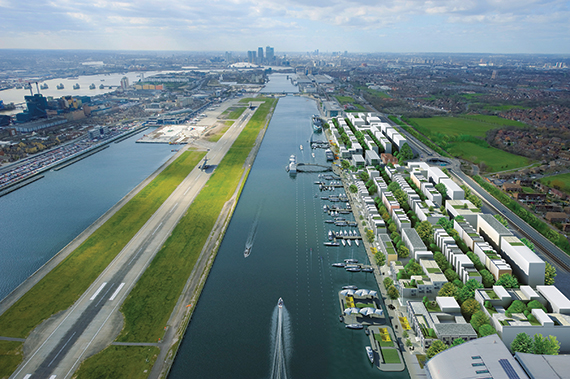 ABP London’s development at the Royal Albert Dock is big. By London standards, it is huge, providing one of the largest single influxes of office space in years, if not decades.
ABP London’s development at the Royal Albert Dock is big. By London standards, it is huge, providing one of the largest single influxes of office space in years, if not decades.
But while 4.7m sq ft of commercial space is making headlines in London, take a look at what ABP is doing in China for a new perspective on the scale on which the company is used to building.
Added up, ABP’s current schemes under construction in Haining, Shenyang and Qingdao will provide more than 4,000 individual offices. Its completed Beijing scheme – relatively small by comparison – still includes 300 individual offices.
Compared with the London scheme – one of the biggest under construction in the capital – the China projects come in at more than 10 times the size.
In terms of size and logistics, London should be a drop in the ocean. For ABP, however, developing in the UK comes with its own set of challenges.
But as the Chinese economy starts to show serious signs of trouble ahead, ABP’s team explains that this is why the company came to London in the first place.
The time factor
But back to the challenges. Time is one of them, says John Miu, executive director of ABP London. “It’s just taking much longer for planning,” he says.
ABP vice-chairman Nancy Xu – daughter of ABP chairman Xu Weiping – agrees. “Chinese companies going global are very hot at the moment,” she says.
“When they have that direction, they will move very fast. That’s why we said time is always a concern.
“We want to build as soon as possible to show the market we have a product and it is suitable for enterprises to come to the UK.”
Quickly, Miu adds: “We don’t actually see London as a challenge. We say it’s a process, changing from one market into another. It’s not a challenge, it’s adapting to a different system.”
But time – and the UK’s planning and regulatory systems – aside, what ABP is proposing to do in east London is very different from what it is doing in the Far East.
With the towers of Canary Wharf looming in the distance, acting as a stark reminder of how locations can empty after 6pm, public realm is something that ABP London’s partners have focused on, says Piers Nickalls, director at Savills. “That is the single biggest focus with Stanhope and ABP at the moment, improving the public realm and improving the food and beverage provision,” he says.
“On the basis of whether we are looking to attract public or private business, we have to demonstrate a well-thought-out public realm.”
ABP chairman Xu Weiping is also willing to admit that mistakes were made in ABP’s first development in Beijing. “Of course, there are many areas that are not so good, because it was the first time we built a park that applied the ABP model,” he says.
Serviced apartments
“For example, [one problem was] the architecture, the design of the buildings. We needed more commercial facilities, more serviced apartments. For ABP London, we will change the design and add more serviced apartments.”
That is something that does not worry Sir Robin Wales, mayor of Newham, who points instead to the glut of development at the nearby Royal Victoria Dock and across the water at Silvertown that will assist in placemaking.
“When we moved to our building in the docks, people said there’s nothing there, it’s a desert,” he says. “But with us there it’s less of a desert. There will be more things happening. It’s a big space and there’s lots to develop. What happens when Silvertown has developed, and ABP has developed, and ABP reaches out to the university? It will be a very different place.”
Wales is also keen not to fill too much of the waterside
with residential development, which is difficult to turn into anything else.
Current plans for the site do include more public realm than ABP’s China schemes, as well as nearly 500,000 sq ft of ground-floor retail and leisure, while 20% of the scheme is residential. This was worked up in part after ABP was awarded the docks, in due diligence discussions with the Greater London Authority and London borough of Newham.
Different models
Xu is keen to emphasise the differences between the firm’s schemes in the West and East. “In China, McDonald’s has changed its model, providing a breakfast more suitable for the Chinese market,” he says. “For ABP, we will have different models and different positioning in Haining and Shenyang, and London, though our service spirit will always stay the same.”
The Royal Albert Dock will also be ABP’s first scheme for which it is having to attract development finance. The firm’s Chinese developments were all financed by private ABP capital.
ABP has said it is planning to use £500m of equity and up to £1.2bn in finance to fund the scheme, depending on how much is sold in the earlier phases. This cash will be ploughed back into developing the later stages.
At the moment, rumours abound about who is investing, with Minsheng Bank announcing in February that it would invest in the scheme.
More concrete investment into the equity component of the scheme came earlier this year, when residential developer Strawberry Star bought an 8% share for £40m, essentially acquiring 50% of the residential component.
And last month Estates Gazette revealed that Citic, a huge Chinese conglomerate with a substantial construction arm, will be taking a £100m equity stake in the scheme.
Attracting tenants and buyers will also be top priority.
So far, 13 companies have each placed reservation fees of £50,000 for buildings in phase one, including Savills, Globe Group, David Tang & Co Solicitors, German Pool, New Zhong Yuen Group, CDL Group and China Insurance Consultants – a subsidiary of China Taiping Insurance.
Nickalls says the flexibility of the scheme, as well as the price, will be a major draw for occupiers, and this should create a diverse occupier base, ranging from small and medium-sized businesses to international companies with no previous presence in London or the UK.
Bricks on the ground
At the moment, no companies from mainland China have yet taken space, though ABP is keen to stress that this is because Chinese companies like to see bricks on the ground before making an investment.
Nancy Xu adds: “The Chinese enterprises are coming out. We are thinking about that. They are starting to prepare and set up. ABP’s product is very convenient and flexible – there is a lot of choice for individual needs. Maybe in the beginning a tenant can afford only one floor, and then maybe the next year they increase their market. So it’s a growing process.”
ABP is also keen to stress that while developing in the two markets is very different, its experiences in China will bring with them their own
set of opportunities for the docks scheme.
Firstly, ABP will bring a new kind of office model to London and the UK. Miu says it wants to offer firms the opportunity to own their own building in London, rather than just rent a couple of floors.
This, coupled with the scale of the scheme, means ABP is intending to create a “headquarters economic culture” which, says Miu, is about building a business community. “In an HQ economy, you gather all the decision-makers in one location, where the business community can interact.”
“It’s an important idea,” adds Nancy Xu, “because wherever we build a project, we are also creating a district.”
The idea of a headquarters culture feeds into ABP’s plans to lure international companies into the docks, and into London. The GLA was keen to encourage this when it agreed the development with ABP, with London mayor Boris Johnson saying the development would be a beacon for Asian investors looking west.
Xu is also keen to attract banks to the scheme. He says: “ABP will bring in many banks from Asia, such as the Bank of China, and banks from South Korea, Japan and India to provide financial services for our occupiers, and to set up an industrial development fund for the SMEs.
“Financial services is one of the most important parts of our services for occupiers, and we want to make Royal Albert Dock the third financial district in London, with Asian banks at its core.”
Also key to facilitating increased trade between the UK and China, and finding more occupiers for the scheme, has been the creation of the ABP International Alliance,
a programme that will essentially introduce the hundreds of occupiers in ABP’s Chinese schemes to businesses in London.
So far, more than 200 companies have signed up to the alliance in China, although none has yet signed up in the UK. Miu says ABP is recruiting at two levels here – for both strategic and normal members.
“At this stage, International Alliance China is more important for the UK,” says Nancy Xu. “We promote the UK to the Chinese enterprises, through the alliance, because we have the resources, we have the understanding of how the opportunity works, what is going on in the UK, and why it is such a useful and meaningful opportunity for the Chinese occupiers to go to the UK.”
This is something that Newham council is also keen to encourage, because the scheme has the potential to create 20,000 jobs.
However, the council has its own priorities in ensuring those jobs go to Newham residents through its Workplace programme.
Wales says: “I have seen places elsewhere where you get new buildings and developments. Firms move in, but locals will not get the jobs because they lose out against international competition. We have, in Workplace, something that can convert that opportunity into jobs.”
Of course, with the current threats to the Chinese economy, there are questions about the viability of the development, although this is why ABP came to London, says Miu.
“London is its own different market from the Chinese market, and now there may be even more reasons for people to invest outside the country, because it will diversify the risk and allow the exploration of a new market,” he adds.
Wider economics
Wales, too, is unperturbed by the possibility of wider economics upsetting the development. “Things happen,” he says. “If companies go bust, they go bust. I thinks it’s rather unlikely, but that’s what they said about Lehman Brothers. You don’t know what’s going to happen – you just do the best you can.
“We are also relying on the GLA due diligence – it was its land, so that was its decision.”
And, scepticism aside, ABP is developing a huge swathe of London that has stood vacant for more than 30 years, while promising to bring dozens of new companies into the London market and create thousands of jobs.
The first tranche of occupiers has already signed up for phase one, and ground will soon be broken for its construction.
The challenges for any such scheme will be massive, but massive is what ABP does. If it manages to pull off the development, it could open up a huge new area of east London, improve links between the UK and China, and create a business district to rival the City core.
Not bad for one company.











